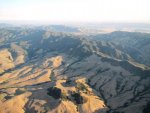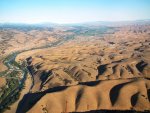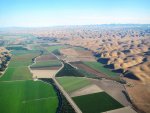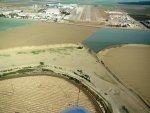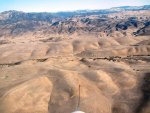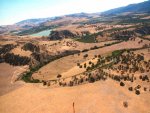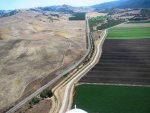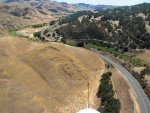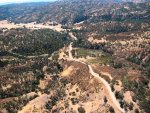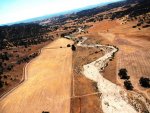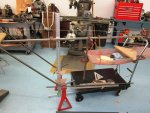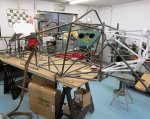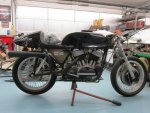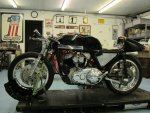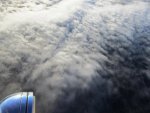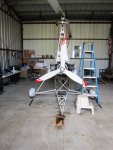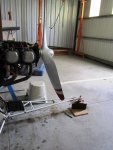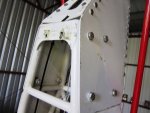A conundrum resolved.
A conundrum resolved.
The plan was to put the bolt on semi finished keel in Vince’s hands so he could manage the mounts for the empennage and then send the completed tail back to Jim so he could finish the keel. This was in retrospect not best practice.
Jim balked at building a keel that had a temporary finish on it so that Vince could manage the mounts.
This was my suggestion because it seemed like a good way to move forward.
Jim is fussy about load paths and as he got closer to finishing the design of the keel he became concerned about the lacing for the truss being in the right place. I am grateful for his resolve.
Vince couldn’t make the mounts until he knew where the keel ended.
I knew it was time for me to have some face to face with Vince and Mike so I had the M Roadster serviced, packed my bag for a couple of days and prepared to leave for Hollister the morning at O’dark hundred the next morning. I gave Vince a call to make sure he could make time for me. I had no clear goal in mind or even a path to progress and therefore didn’t know how long it would take.
It was still dark when I began to get ready to leave. I checked the weather and found it was already VFR at SMX so I packed everything in a different suitcase and headed for the airport.
The sun was just coming up as I performed a thorough preflight. I added a quart of oil and filled out the engine log book.
It was still a little cold so I put on a sweat shirt beneath my flight suit.
I called Lockheed Martin for a flight from SMX to CVH and there was an AIRMET for low ceilings and mountain obscuration. I called the SBP ATIS, checked PRB’s ASOS and Checked the SNS ATIS. SNS was IFR but everything else looked good.
The Predator burst to life with just a touch of the button and settled down to an even idle. She seemed excited and ready for adventure. I called ground with Juliette and was to taxi to runway 30 via Alpha.
The run up went well and I runway 30 was clear for takeoff with a straight out departure.
She leapt into the air and climbed out quickly in the cool dense air. I pulled her back to 2,300 rpm and 65kts and she continued to climb. We hit an inversion at 2,000 feet and it was suddenly a warm summer day.
Ten Miles South East of SBP at 3,000 feet MSL I asked ATC for an overhead transition to the North West. It was approved as requested. I played a little dodgem with one aircraft not on frequency and was soon over the pass and began my descent. It was a perfect day to fly with just enough turbulence to romance the wind.
The morning light made the hills come alive with shadows as we followed the river North West toward King City past the Hunter Legit MOA.
We had been rumbling along at 65kts indicated air speed showing 78kts of ground speed on the GPS. As we descended there was a wind shear at 1,800 feet MSL and the wind changed direction 180 degrees and became a slight head wind. We climbed back up to 2,000 feet MSL as King City (KIC) came into view.
There was no one in the pattern so we made a left base entry for runway 29.
A third of the way down the runway the wind shifted again and we overshot the midfield taxiway. I put the power back in because it was quite a way to the next taxiway. The touchdown was nice and I waved at my friends as I taxied to fuel.
A quick visit to the empty pilot’s lounge and we were airborne again and looking for my valley that goes all the way to Hollister. The hills were rugged and imposing but we were soon invited into the lush valley.
In about 40 minutes of particularly lovely flying Hollister came into view. The Hollister airport (CVH) is on the far side of town. As we descended through the wind shear the wind again changed to a slight quartering head wind. As the airport came into view the tetrahedron couldn’t quite make up its mind so we made a base entry for runway 31 and landed with a bit of a crosswind at the taxiway before the crosswind runway.
We taxied to transient parking, tied her down and stowed our gear at Galivan Aviation and headed toward Corbin Saddle.
Vince was not hard to find and we began to work on a drawing to send Jim. Mike joined us and came up with a mounting plate concept. As we struggled with the structural details and the attachment scheme Vince sort of lit up and said “let me take a splash from the mold of the part where the mount goes and send it to Jim and with the spars and ribs drawn in and he can make a plate, mount it to the keel and send it back.”
This is a great solution because it leaves the fabrication in the hands of the people who are best equipped to handle that particular material.
I called Jim and he said it was “better than I had hoped for.”
Things can be a little touchy when you are mixing artists that are doing it for the art.
Vince is going to make it happen as soon as possible.
Pleased with the results and feeling on a roll I went to visit the airport manager and propose flying in the Hollister Air Show. He asked for some material to show to the rest of the decision makers and we discussed my inability to receive compensation until I get my commercial and what it would take to manage the local FSDO. I left there quite pleased with the way the day was going with a lovely flight home ahead of me. I had a nice brunch at the Din a Ling café, picked up my gear and gassed her up.
The tetrahedron had made up its mind and we took off from runway 24 with a left crosswind departure to the South East. I stayed low all the way to Paso Robles to keep the 8kt tail wind.
Mission accomplished.
Thank you, Vance

